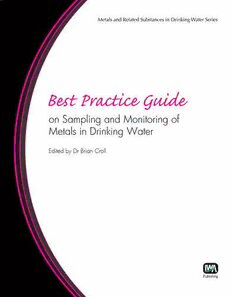
Best Practice Guide on Sampling and Monitoring Metals in Drinking Water PDF
Preview Best Practice Guide on Sampling and Monitoring Metals in Drinking Water
Best Practice Guide on the Sampling and Monitoring of Metals in Drinking Water Metals and Related Substances in Drinking Water Best Practice Guide on the Sampling and Monitoring of Metals in Drinking Water Edited by Dr Adam Postawa AGH University, PL Publishedby IWAPublishing AllianceHouse 12CaxtonStreet LondonSW1H0QS,UK Telephone:+44(0)2076545500 Fax:+44(0)2076545555 Email:[email protected] Web:www.iwapublishing.com Firstpublished2012 ©2012IWAPublishing Apartfromanyfairdealingforthepurposesofresearchorprivatestudy,orcriticismorreview,aspermittedundertheUK Copyright,DesignsandPatentsAct(1998),nopartofthispublicationmaybereproduced,storedortransmittedinany form or by any means, without the prior permission in writing of the publisher, or, in the case of photographic reproduction, in accordance with the terms of licenses issued by the Copyright Licensing Agency in the UK, or in accordance with the terms of licenses issued by the appropriate reproduction rights organization outside the UK. EnquiriesconcerningreproductionoutsidethetermsstatedhereshouldbesenttoIWAPublishingattheaddressprinted above. Thepublishermakesnorepresentation,expressorimplied,withregardtotheaccuracyoftheinformationcontainedinthis bookandcannotacceptanylegalresponsibilityorliabilityforerrorsoromissionsthatmaybemade. Disclaimer TheinformationprovidedandtheopinionsgiveninthispublicationarenotnecessarilythoseofIWAandshouldnotbeacted uponwithoutindependentconsiderationandprofessionaladvice.IWAandtheAuthorwillnotacceptresponsibilityforany lossordamagesufferedbyanypersonactingorrefrainingfromactinguponanymaterialcontainedinthispublication. BritishLibraryCataloguinginPublicationData ACIPcataloguerecordforthisbookisavailablefromtheBritishLibrary ISBN9781843393832(Paperback) ISBN9781780400792(eBook) Contents About this Best Practice Guide .............................................. ix Authors .................................................................... xi Acknowledgements ........................................................ xiii Acronyms ................................................................. xv Definitions ............................................................... xvii Foreword .................................................................. xix Executive Summary ....................................................... xxi Chapter 1 Introduction ................................................................ 1 1.1 TheScopeoftheBestPracticeGuide .......................................... 1 1.2 TheRoleofSamplingandMonitoring ........................................... 2 1.3 DrinkingWaterSafetyPlanning ................................................ 9 1.4 ThePotentialConsequencesofPoorSamplingandMonitoring .................... 10 1.5 LayoutoftheBestPracticeGuide ............................................. 10 Chapter 2 Basic principles of sampling ............................................... 13 2.1 HealthandSafety ........................................................... 13 2.2 DesignofSamplingProgrammes ............................................. 15 2.3 SamplingTechniques ........................................................ 17 2.4 SamplingEquipment ........................................................ 19 2.5 SamplePretreatmentandPreservation ........................................ 19 vi BestPracticeGuideontheSamplingandMonitoringofMetalsinDrinkingWater Chapter 3 Quality assurance of sampling procedures ................................. 25 3.1 RoleofQualityAssurance .................................................... 25 3.2 SamplingStrategy .......................................................... 25 3.3 ValidationofSamplingProcedure ............................................. 25 3.4 QualityControlProgramme ................................................... 26 Chapter 4 Analytical methods for metals in water ..................................... 31 4.1 SelectionofanAnalyticalMethod ............................................. 31 4.2 ColorimetricMethods ........................................................ 32 4.3 ElectrochemistryMethods .................................................... 34 4.4 AtomicAbsorptionSpectroscopyMethods ...................................... 35 4.5 InductivelyCoupledPlasmaMethods(ICP) ..................................... 39 Chapter 5 Analytical quality control .................................................. 41 5.1 PerformanceCharacteristics .................................................. 41 5.2 InternalQualityControl ...................................................... 41 5.3 ExternalQualityControl ...................................................... 42 5.4 ExampleofanAnalyticalQualityControlProgram ............................... 42 Chapter 6 Monitoring metals in raw water resources .................................. 45 6.1 WhatisRawWater? ........................................................ 45 6.2 ReasonsforMonitoringRawWater ............................................ 45 6.3 TypesofSamples ........................................................... 45 6.4 SamplingLocations ......................................................... 46 6.5 SamplingFrequency ........................................................ 54 6.6 SamplingDevices ........................................................... 55 6.7 AutomaticSamplingandOnlineAnalysisSystems ............................... 59 6.8 PassiveSampling ........................................................... 59 Chapter 7 Sampling and monitoring metals in water treatment ......................... 61 7.1 MetalsSignificantforWaterTreatment ......................................... 61 7.2 ReasonsforMonitoring ...................................................... 62 7.3 MonitoringLocations ........................................................ 63 7.4 MethodsofMonitoring ....................................................... 65 7.5 InterpretationofData ........................................................ 66 Chapter 8 Monitoring metals in distribution systems .................................. 69 8.1 MetalsCausingProblemsinDistributionSystems ............................... 69 Contents vii 8.2 ReasonsforMonitoring ...................................................... 70 8.3 PlanningaSampleSurvey ................................................... 70 8.4 MonitoringLocations ........................................................ 71 8.5 MethodsofMonitoring ....................................................... 72 8.6 InterpretationofData ........................................................ 73 Chapter 9 Monitoring metals at consumers’ taps ...................................... 75 9.1 RelevanceofConsumer’sTap ................................................ 75 9.2 SamplingMethods .......................................................... 75 9.3 ZonalMonitoring ............................................................ 80 9.4 InvestigationsatIndividualProperties .......................................... 84 Chapter 10 Statistical tools for the evaluation of results ................................ 87 10.1 BasicDefinitions ........................................................... 87 10.2 SelectedParametricandNonparametricStatisticalTests ........................ 90 10.3 ConfidenceIntervalforMean ................................................ 93 10.4 CompliancewithThresholds ................................................. 94 10.5 AnovaandRobustAnova ................................................... 96 10.6 DataPresentation .......................................................... 98 Chapter 11 Developing monitoring strategies ......................................... 107 11.1 SourcetoTapOverview ................................................... 107 11.2 ReasonsforMonitoring .................................................... 107 11.3 ConsequencesofInadequateMonitoringData ................................ 110 11.4 StepstoDevelopingaSuccessfulMonitoringStrategy ......................... 110 Appendix 1 ............................................................... 111 Case studies ............................................................. 111 A1.1 Bucharest(RO) .......................................................... 111 A1.2 EnglandandWales(UK) .................................................. 113 A1.3 Krakow(PL) ............................................................. 116 A1.4 Myszkow(PL) ............................................................ 117 A1.5 TarguMures(RO) ........................................................ 118 A1.6 Timisoara(RO) ........................................................... 121 References ............................................................... 125 About this Best Practice Guide ThisGuideisoneofaseriesproducedbytheInternationalWaterAssociation’sSpecialistGrouponMetals andRelatedSubstancesinDrinkingWater.Itisastate-of-the-artcompilationoftherangeofscientificand operationalissues concerned withthesamplingofmetalsindrinkingwater.Itwill beofinterest towater utilitypractitioners,researchers,healthagenciesandpolicymakers. The Specialist Group (and its predecessor COST Action 637) is an active research network and has regularly convened international conferences and seminars. It has close working links with the World Health Organization, the European Commission’s Joint Research Centre, Health Canada and the US EnvironmentalProtectionAgency. TheGuideissupportedbyatwo-daytrainingcourseandanabbreviatedversionoftheGuideaimedat small community water suppliers. Information about training, the guide for small community water suppliersandtheresearchnetworkingeneralisavailablefromwww.iwahq.org Authors DrAdamPostawa,AGHUniversity(PL) MariaJoãoBenoliel,EPAL(PT) MatthewBower,DrinkingWaterQualityRegulatorforScotland(UK) DrBrianCroll,Consultant(UK) DrColinHayes,SwanseaUniversity(UK) DrEddoHoekstra,JRC(EC) DrEwaKmiecik,AGHUniversity(PL) AndréMiranda,EPAL(PT) JoãoMiguelPaiva,EPAL(PT) ÁgnesSebastyén,NIEH(HU) MarcelTielemans,Waterlaboratorium(NL) DrGabriellaVasile,INCD-ECOIND(RO) Acknowledgements ThisBestPracticeGuidederivesfromtheknowledgeinitiallyassembledbytheEuropeanresearchnetwork COSTAction637,supportedbyawiderangeofexpertsfrom26Europeancountries,theUSandCanada. ThefundingreceivedfromCOSTovertheperiodDecember2006toNovember2010isdulyacknowledged. ThemainobjectiveofCOSTAction637wastostimulatebettercontrolofmetalsindrinkingwaterand tominimiseenvironmentalandhealthimpacts.TheActionaimedtocontributetotheimplementationofthe EuropeanDrinkingWaterDirectiveandtotheEnvironmentandHealthprogrammeoftheEUCommission andtheUN/WHOProtocolonWaterandHealth.TheJointResearchCentreoftheEuropeanCommission provided scientific input in the COST Action but was also the link to the European Commission. COST standsforEuropeanCooperationinScienceandTechnologyandistheoldestandwidestEuropeaninter- governmental network for cooperation in research. COST is supported by the EU RTD Framework programme. SinceNovember2010,theresearchnetworkhascontinuedtobeactiveasaSpecialistGroupwithinthe InternationalWaterAssociation. Thanksareduetoallthewatercompanies,regulators,healthagenciesandresearchinstituteswhohave providedaccesstodata. SpecialwordsofgratitudeareduetoDrBrianCroll,whowastheinitialEditor.Withouthim,preparation ofthisBestPracticeGuidewouldnothavebeenpossible.
